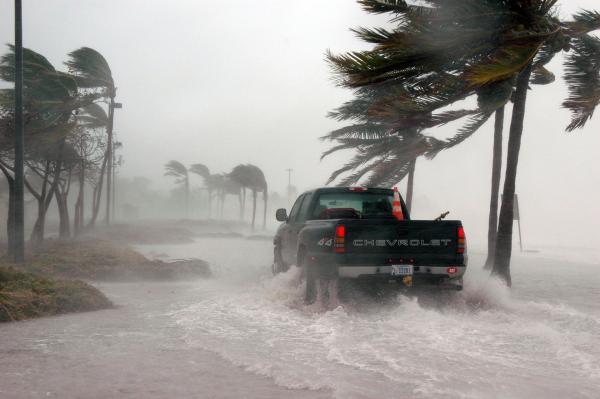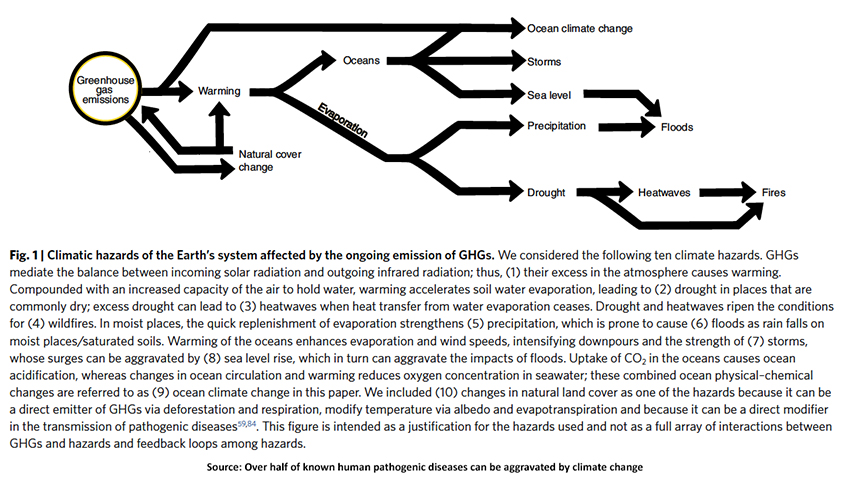All of “God’s creatures,” from the viruses and fungi to humans, have, through the forces of evolution, developed biological niches – the range they occupy across the earth and where we stand in the food chain. Climate and natural disasters play a huge role in those relationships, and our biological niches change with our changing climate. Warming seawater alters the habitat of shark's prey and explains, in part, the increase in sharks along our populated beaches. Aid workers returning from Haiti after the 2010 earthquake brought home higher incidences of malaria and dengue fever. A new paper in Nature Climate Change looks at what we know about the relationship between pathogens, like viruses, bacteria, and fungi, and climate hazards.
“The combination of numerous climatic hazards by the numerous pathogens reveals the potentially large number of interactions in which climatic hazards could aggravate human pathogenic diseases….”
The Nature study is a literature review of how pathogenic disease is affected by climatic hazards. These hazards are described in this figure from the study below.
Across 77,000 possible articles, the researchers identified 830 that described “an explicit climatic hazard … affecting an explicit pathogenic disease … in an implicit place and or time.” In essence, real-world data. They identified 286 unique diseases, 58% of the infectious diseases known to “impact humanity worldwide.” Media reports featured that percentage
“A whopping 58% of an authoritative list of infectious diseases documented to have impacted humanity have already been shown to be aggravated by climatic hazards -- a finding the researchers found "shocking," Mora said.” ABC News
The analysis concentrated on those 286 unique diseases. Here are some highlights.
- 1006 unique combination of climatic hazards and pathogens
- Pathogens are most frequently transmitted at higher rates because of increasing vectors, like mosquitos
- Warming temperatures, increasing precipitation (increasing humidity), floods, and drought all increase the pathogens' presence.
Across all of these combinations, two specific trends emerged; pathogens and humans become physically closer, and the strength of pathogens rises as our biological responses weaken.
Climatic hazards bring pathogens closer to people
Climate change allows for expanding the geographical range of species in both land and sea creatures. Habitat disruption by floods or limitations of food sources by drought motivates animals to find new, more favorable habitats. And drought can also concentrate pathogens as they cluster around the remaining sources of water habitats. Scientists have warned for some time that as the permafrost thaws, it will uncover a “Pandora’s box” of pathogens we have not seen for centuries.
Climatic hazards bringing people closer to pathogens
Changes in our land use as we move closer to nature (or it moves closer to us) also bring us closer to pathogens, e.g., Lyme disease. Changes in our recreation, specifically water-related activities, or just alterations in precipitation and temperature, affect pathogens' transmissibility at large gatherings. Displacement of human populations by natural disasters, such as floods or man-made disasters, such as the war in Ukraine or the desperate poverty of Central and South America, all result in crowded human habitats without significantly hygenic sewage and water
Pathogens strengthened by climatic hazards
The ocean warming brings us more harmful algal blooms, and heavy precipitation creates stagnant waters amenable to mosquitos as disease vectors. Warming temperatures “upregulate gene expression of proteins affecting transmission, adhesion, penetration, survival and host injury by Vibrio spp,” the cause of cholera which affects nearly 2.8 million globally.
People are impaired by climatic hazard
While there is controversy over whether cold is more lethal than heat, all of us might agree, especially after this summer, that heat puts stress on us And stress alters our biological responses, leaving us for more extended periods in a “fight or flight” arousal, reducing our resistance to infectious disease. The changing distribution of water also impacts our health. Too little or too much can damage our built infrastructure of water filtration and sewage systems.
The analysis details several climate scenarios and pathogens that may adversely impact our species as our home continues to warm. It is limited because the underlying studies were not sufficiently long enough that other changes to the environment might mitigate the effects seen. For example, was the rise of mosquitos ultimately reduced by a concomitant but a lagging rise in their predators?
Whether you think greenhouse gases from human sources are the cause of rising temperatures or not is irrelevant to the findings. The authors have provided an interesting interactive version of their results online for those interested in a deeper dive.
[1] 98.6 degrees Fahrenheit ideal temperature for keeping fungi away and food at bay
Source: Over half of known human pathogenic diseases can be aggravated by climate change Nature Climate Change DOI: 10.1038/s41558-022-01426-1





